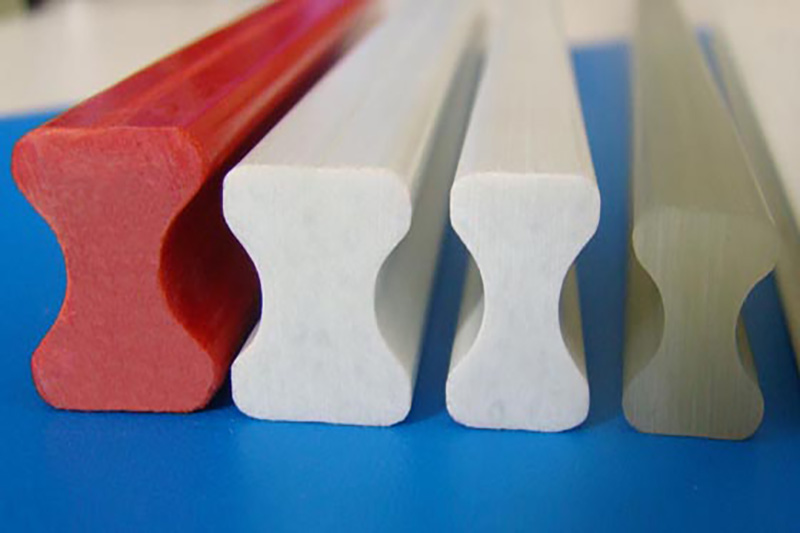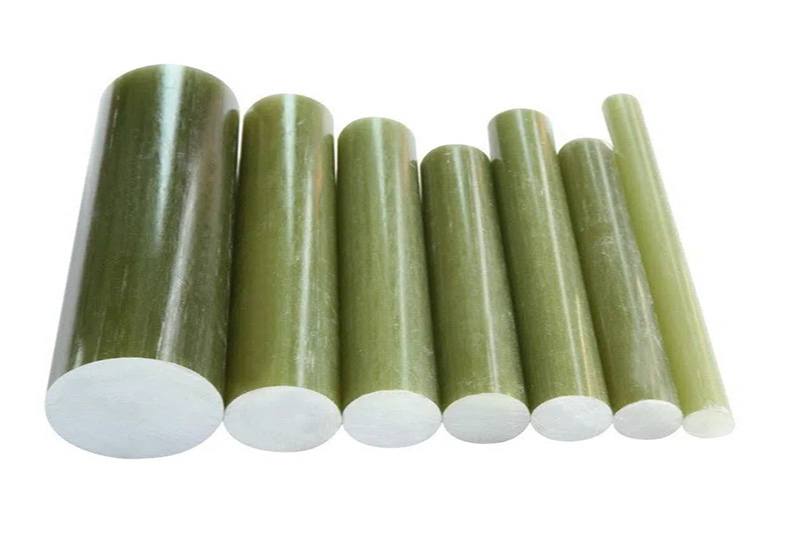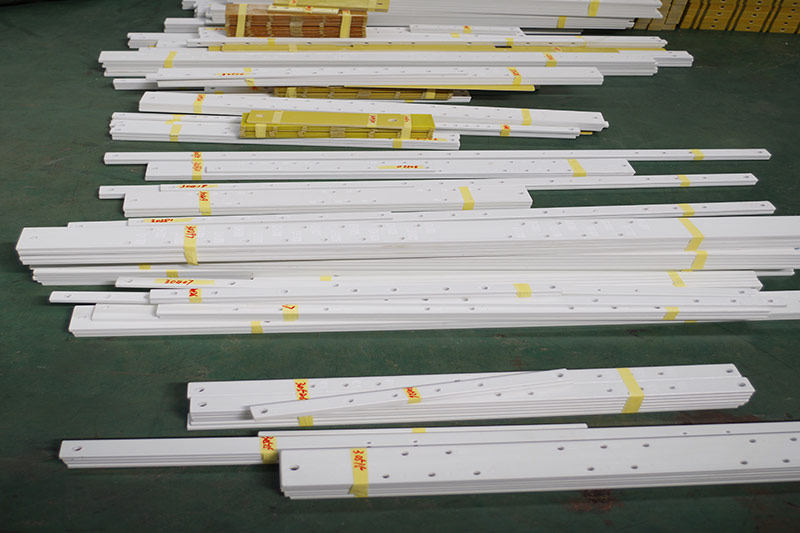Pultrusion composite materials, also known as pultruded composites, are a type of composite material that is manufactured through the pultrusion process. Pultrusion is a continuous manufacturing process in which reinforcing fibers, such as fiberglass or carbon fiber, are impregnated with a polymer resin and then pulled through a heated die. The die shapes the composite material into the desired profile, such as rods, tubes, or beams, while simultaneously curing the resin. This results in a high-strength, lightweight, and durable composite material with excellent mechanical properties. Today we will lead you to understand the pultruded composite materials produced by our company, and explain to you the production principles of pultruded composite materials and the application scenarios of pultruded composite materials.

Our company produces pultruded composite materials, which are categorized into unsaturated polyester pultruded components and epoxy pultruded rods based on the resin used. Here are the specific differences between these two products:
1.Different Resin Materials:
Unsaturated polyester pultruded components are made by combining fiberglass yarn as the base material with unsaturated polyester resin. Epoxy pultruded rods, on the other hand, are made by combining fiberglass yarn as the base material with epoxy resin. The main difference lies in the type of resin used.
2.Different Colors:
Unsaturated polyester pultruded components are primarily available in red and white colors, while epoxy pultruded rods are typically green in color.
3.Different Temperature Resistance:
Unsaturated polyester pultruded components have a temperature resistance rating of Class B, capable of withstanding temperatures up to 130°C. Epoxy pultruded rods, on the other hand, have a temperature resistance rating of Class F, capable of withstanding temperatures up to 155°C. Epoxy pultruded rods exhibit higher temperature resistance compared to unsaturated polyester pultruded components.
These are the specific differences between these two products. However, apart from these differences, both products have similar applications. Now that you have an understanding of these two products, I will guide you through some of the manufacturing principles and applications of pultruded composite materials.

1.Fiber Reinforcement:
The process begins with the reinforcement of fibers, such as fiberglass or carbon fiber. These fibers, known for their high strength and stiffness, are pulled from spools and guided through a resin bath.
2.Resin Impregnation:
In the resin bath, the fibers are thoroughly impregnated with a liquid resin. This impregnation process ensures that the fibers are fully saturated with the resin, which will provide strength and durability to the final composite material.
3.Preforming:
Once the fibers are impregnated, they are guided through preforming guides that help align the fibers in the desired orientation. This step ensures that the fibers are properly arranged for optimal strength and performance.
4.Mold Design and Function:
The aligned fibers then pass through a heated steel mold, commonly referred to as a die. The die is carefully designed to shape the composite material into the desired profile, such as rods, tubes, or beams. It plays a crucial role in maintaining the shape, dimensions, and surface finish of the final product.
5.Curing:
As the fibers pass through the die, the resin undergoes a curing process. This process may involve the application of heat or the use of ultraviolet light, depending on the specific resin system. The curing solidifies the resin, creating a rigid and durable composite material.
6.Tension Control:
Throughout the pultrusion process, tension is applied to the fibers to ensure they remain straight and properly aligned. This tension control helps achieve the desired mechanical properties and minimizes defects in the final product.
By following these basic principles, pultruded composite manufacturers can produce high-strength, lightweight, and durable materials that find applications in various industries
Pultruded composite materials have a wide range of applications, particularly in the electrical and electronics industry. The exceptional properties of these materials make them ideal for various electrical applications. Here are some key applications:

1.Insulating Supports:
Pultruded composites are commonly used in electrical insulating supports, such as insulators and busbar supports. These materials offer excellent electrical insulation properties, high mechanical strength, and dimensional stability, ensuring reliable and safe operation in electrical systems.
2.Cable Trays:
Pultruded composite cable trays provide a lightweight and corrosion-resistant solution for cable management in electrical installations. These trays offer high strength, durability, and excellent resistance to chemicals and UV radiation, making them suitable for both indoor and outdoor applications.
3.Electrical Enclosures:
Pultruded composites are used in the manufacturing of electrical enclosures, including switchgear cabinets and control panels. These materials provide excellent electrical insulation, thermal stability, and resistance to environmental factors, ensuring the protection of electrical components.
4.Insulating Tubes and Rods:
Pultruded composite materials are used to produce insulating tubes and rods used in electrical installations. These tubes and rods offer high dielectric strength, dimensional stability, and resistance to high temperatures. They are commonly used as support structures for power transmission and distribution systems.
5.Transformer Components:
Pultruded composite materials find applications in transformer components, such as coil supports and spacers. These materials offer high mechanical strength, electrical insulation, and resistance to thermal expansion, ensuring the reliable performance of transformers.
6.Electrical Panel Components:
Pultruded composites are used in the manufacturing of electrical panel components, including panel frames and mounting brackets. These materials provide lightweight solutions, high strength, and resistance to chemicals and environmental factors, contributing to the efficient and safe operation of electrical panels.
7.Electrical Insulation Components:
Pultruded composite materials are employed in the production of various electrical insulation components, such as insulating rods, profiles, and strips. These components offer excellent electrical insulation, thermal stability, and resistance to moisture, contributing to the overall efficiency and reliability of electrical systems.
The unique properties of pultruded composite materials make them well-suited for a wide range of electrical applications. Their lightweight nature, high strength, and exceptional electrical insulation properties contribute to the development of reliable and efficient electrical systems.
Pultruded composite materials are an excellent choice for a variety of applications, particularly in the electrical and electronics industry. These materials offer exceptional mechanical properties, electrical insulation, and resistance to environmental factors, making them ideal for insulating supports, cable trays, electrical enclosures, transformer components, and more.We support customization and can provide free samples. If you have product needs or technical consultation, you are welcome to contact us at any time.
If you need our products please write down any questions, we will reply as soon as possible.
There are three ISO certificates for quality certification. The certificates will be shown later. ISO
After receiving the advance payment, the production cycle is 15-25 days. And the transportation cycle should be calcul……
We supply with installation guide and user manual for each transformer. If you do not understand them. We will offer v……